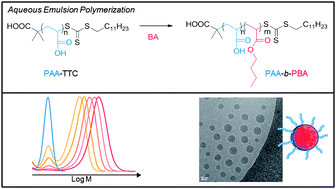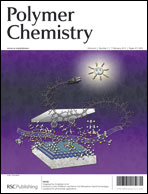Ab initio RAFT emulsion polymerization of butyl acrylate mediated by poly(acrylic acid) trithiocarbonate†‡
Abstract
We describe a very simple and straightforward strategy towards self-stabilized poly(acrylic acid)-block-poly(butyl acrylate), PAA-b-PBA, block copolymer particles via an ab initio RAFT-controlled emulsion polymerization. Latexes were obtained at 23 wt% solids without the use of additional surfactants, thus avoiding any diffusion issues occurring during film formation. It was possible to reach in a controlled manner PAA-b-PBA diblock copolymers with high molar masses up to 100 kg mol−1. In contrast to previous studies, it was possible to reduce the weight percent of the hydrophilic polymer to 1.2 wt% (with respect to PBA). The block lengths of both PAA and PBA were varied in order to demonstrate the robustness of the system. Ammonium hydroxide was used as a volatile base to adjust the pH of the polymerization medium. Besides improving the polymerization control, ammonium hydroxide is particularly appealing for coating applications, as it can be easily removed during film formation by evaporation. Finally, using these latexes as seeds for the emulsion polymerization of styrene, it was possible to prepare novel nanostructured particles composed of PAA-b-PBA-b-PS triblock copolymers.


 Please wait while we load your content...
Please wait while we load your content...